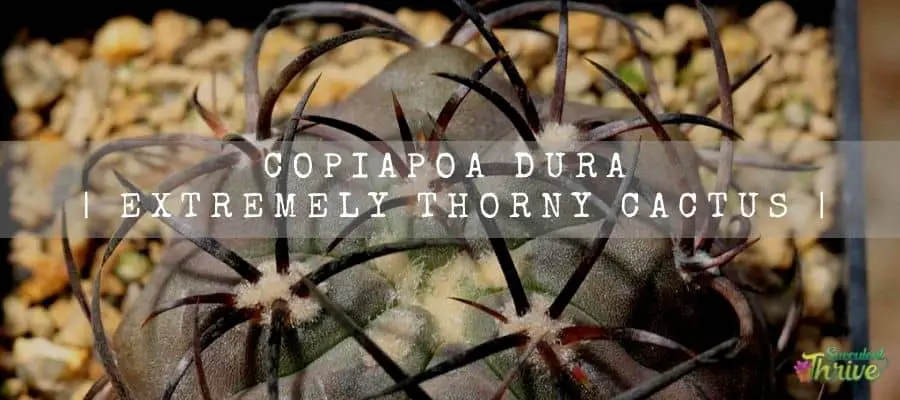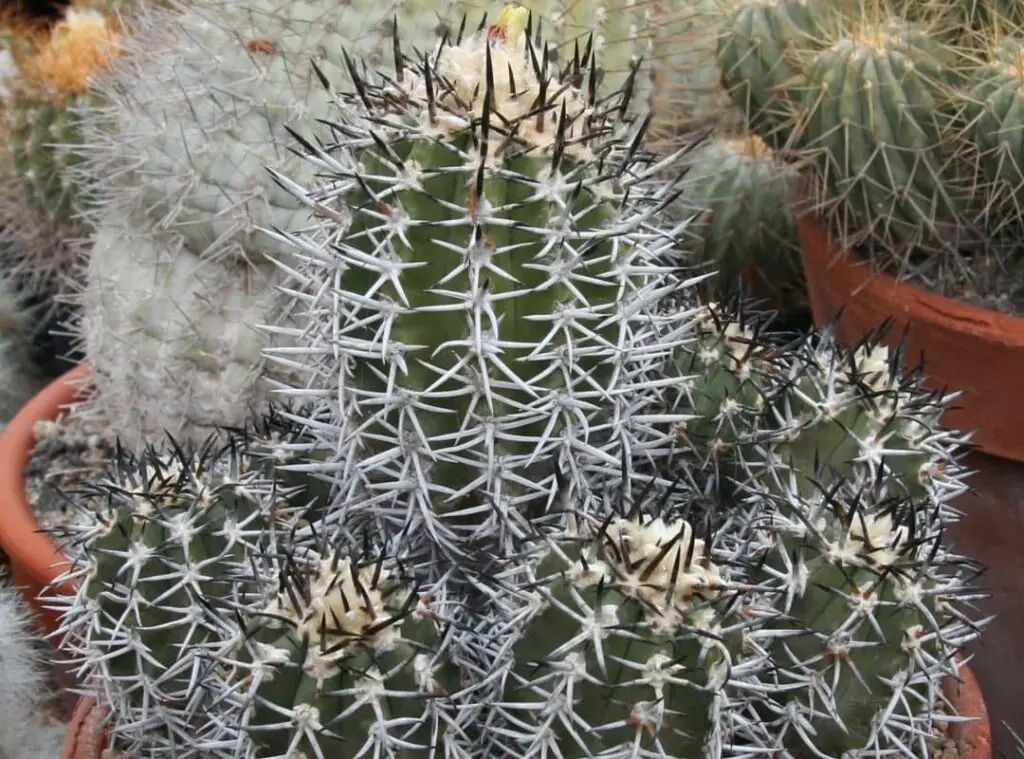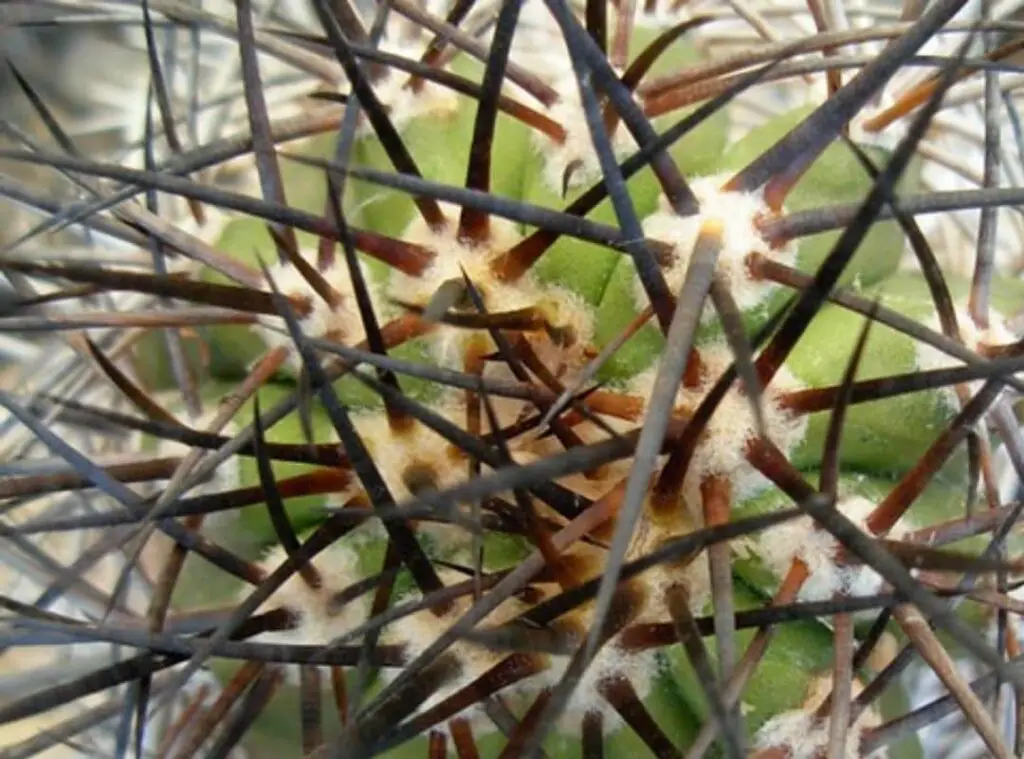Copiapoa dura are local morphological forms of Copiapoa echinoides. It is a widely spread variable species and they are originally from Northern Chile. They go by the common name called Duro.
Copiapoa dura plants are renowned for their distinct solitary growing globose shaped stem.
These are slow growing sets of plants, and anybody can start growing them since they would require minor care treatments from you. If you are interested in growing them, I urge you to read the article till the end.

How do I identify Copiapoa dura?
Copiapoa dura plants have a distinctly formed solitary stem. They would usually form in a clump manner and tend to take a globose shape as well.
You could spot the stem either in brown or in gray green in color. They would usually grow up to a height of 15-30 cm.
Besides they would comprise 11-17 ribs as well. Moreover, you could see them carrying 0-3 central black spines too.
Their roots would be fibrous, and the areoles would be yellow in color. They would become gray as they mature.
Apart from these characteristics, you could see them carrying flowers in pale yellow color. They are scented and would be about 4cm in diameter.
In addition, these plants come up with brown, red colors. They would tend to take a round shape, and they would carry a few scales as well.
Those scales would be 2.5 cm in length. Finally, Copiapoa dura seeds would be black in color.
Growth rate
Copiapoa dura grows at a slow pace.
One look care guide
| Botanical Name | Copiapoa dura |
| Common Name | Duro |
| Plant Type | Cactus |
| Mature Size | Maximum height of 15-30 cm. |
| Sun Exposure | Full sunlight |
| Soil Type | Well-draining / sandy |
| Soil pH | 6.1 to 6.5 (mildly acidic) 6.6 to 7.5 (neutral) 7.6 to 7.8 (mildly alkaline) |
| Bloom Time | Late spring / early summer |
| Flower Color | Pale yellow |
| Hardiness Zones | USDA hardiness zones 10b-11. |
| Native Area | Northern Chile |
| Average price | 7 USD |
How do you take care of Copiapoa dura?
Light Requirement
In terms of the right light levels, they would prefer to have direct sunlight to partial shade just like the rest of other typical succulents and cactus.
They are fans of strong sunlight. That said, bear in mind that you should refrain from exposing the plants to excessive sunlight for too long as it would bring adverse impacts on the plants.
Temperature and humidity
Copiapoa dura are the types of plants which would love to have bright sunlight but not too excessive heat.
Ideally , warmer temperatures would work well with them right throughout and avoid exposing them to colder temperatures for extended periods.
If there is any forecast for frost conditions, you need to bring the plants indoors so that you can protect the plants from the frost. It is important that you practice this since the Copiapoa dura do not have a great frost tolerance.

Is it cold hardy?
Copiapoa dura are cold hardy plants up to -35° F(-37.2° C).
Growth Zone
Copiapoa dura have hardiness in USDA hardiness zones 10b-11.
Watering Requirement
Copiapoa dura used to grow in hot and arid conditions. Hence keep in mind that these plants are quite responsive towards moisture.
As such you need to always water them only if their soil is dry. In other words, you should make sure that you allow their soil to wither between two watering sessions.
Exposure to over water would contribute to so many adverse effects on the plants. Hence you need to always water them moderately and refrain from supplying them water in excess.
If you are unsure whether you need to water the plants, I suggest waiting for a couple of days and then water as underwatering would not result in any major adverse impact on the plants. That said, over watering could do.
Soil Requirement Type / pH
When you select a soil mix to grow the Copiapoa dura, you need to mainly look out whether it has excellent drainage and a good aeration.
It would make the plants less susceptible for diseases such as root rot. Ideally it should consist of clay, coarse sand, vermiculture, coarse gravel etc. as they would perfectly fit in for these plants.
If you end up using a regular soil mix, it will retain more water within the potting medium and make the plants attractive for pests as well as for diseases.
In terms of the right soil mix, I recommend growing them in a slightly alkaline, slightly acid or even neutral soil mix.
Pot size Potting and Repotting
Copiapoa dura would prefer to grow in a pot which has ample drainage.
Further a pot made out of a porous material would suit them the best as the water evaporation would take place much faster in those materials. I recommend growing the plants in terracotta or clay pots as they would fulfill this purpose.
Where to Plant
In simple words, you need to select a spot where they can gain adequate sunlight mainly.
Additionally, when you pot them, you need to provide a soil mix which is well draining, and which is well aerated too.
Fertilizer and time of year
Copiapoa dura do not have higher demand when it comes to fertilizing.
Having said that , a light feeding would be effective on the plants as it would boost the active growth in the plants.
So, I recommend using a commercial fertilizer which is specially designed for cacti. You need to feed them when they are actively growing and suspend feeding when they are dormant.
Make sure that you do not over feed the plants as they would result in feed burns in the plants.

Flower
Copiapoa dura emerge with flowers in pale yellow color. They are carrying a sweet fragrance too. You could spot them flowering late spring or even in early summer.
Dormancy
Copiapoa dura go into dormancy in winter.
Common bugs and illnesses
Copiapoa dura are strong contenders when it comes to resisting the pests’ attacks and the diseases.
With that being said, you need to watch out for regular pests such as mealybugs, scales, and aphids.
They will tend to invade the plants especially if they find the plants hospitable for them. Moreover, excess water would cause root rot. Root rot could be so troublesome, and it can even bring a fatal impact on the plants too.
How to propagate Copiapoa dura
The Seed propagation method would work well with these plants the best. Having said that you could use their offsets also to propagate them.
However, many people opt to go ahead with the seeds propagation method, and it is very rare you could spot them propagating plants through offsets.
Copiapoa dura benefits
These plants would be great to use as gifts due to its unique spherical stems, spines and as well as the ribs. They would be the highlight in your garden if you look after them well and provide the right growing care tips.
Conclusion
Before wrapping this up, I hope this article gives you a broader view on how you should look after them well , the issues you may come across and the mode of propagating them. I hope now you are all set to start growing the plants and get that amazing experience.
Read Next : Portulaca Molokiniensis | A Stunning Succulent |
